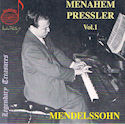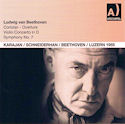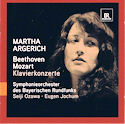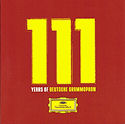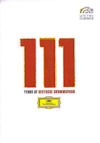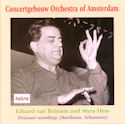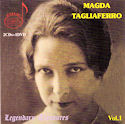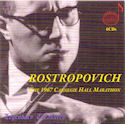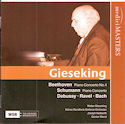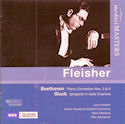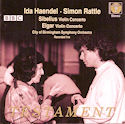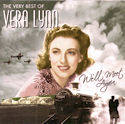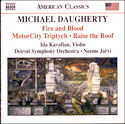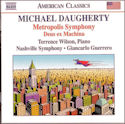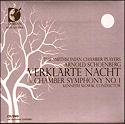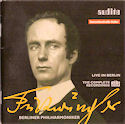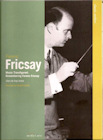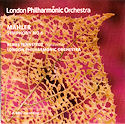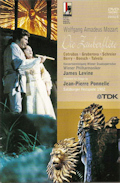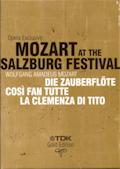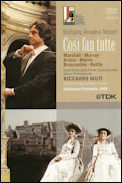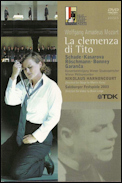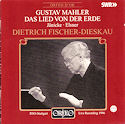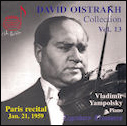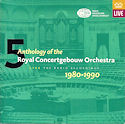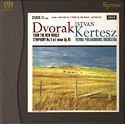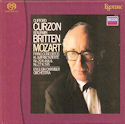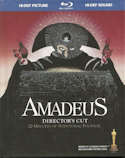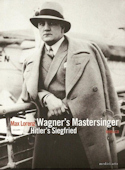OLD WINE IN NEW BOTTLES – Fine Old Recordings re-released - December 2010
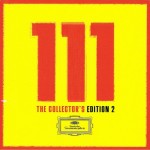 Deutsche Grammophon has issued Volume 2 of their Collector’s Edition celebrating their 111 years of leadership in the recording industry (DG 4779142, 56 CDs). The discs are presented in a cube shaped box that matches the first volume of 55 CDs issued earlier this year. Available space makes it impossible to list the contents or even the artists. Sufficient to say that this is a treasure house of superb recordings of desirable repertoire, both familiar and slightly obscure, from complete operas, Carmen and La Traviata, symphonies, concertos, instrumental recitals, vocal recitals, and the list goes on. DG’s top instrumentalists, singers, orchestras and conductors artists are all here, from Abbado to Zimerman. Each individual disc is sleeved in the original cover-art and the 140 page enclosed booklet includes complete contents and recording data. Retailing at about $2.50 per disc, this limited edition compact box that is much, much bigger on the inside, is rather difficult to resist. Check complete contents at www.deutschegrammophon.com.
Deutsche Grammophon has issued Volume 2 of their Collector’s Edition celebrating their 111 years of leadership in the recording industry (DG 4779142, 56 CDs). The discs are presented in a cube shaped box that matches the first volume of 55 CDs issued earlier this year. Available space makes it impossible to list the contents or even the artists. Sufficient to say that this is a treasure house of superb recordings of desirable repertoire, both familiar and slightly obscure, from complete operas, Carmen and La Traviata, symphonies, concertos, instrumental recitals, vocal recitals, and the list goes on. DG’s top instrumentalists, singers, orchestras and conductors artists are all here, from Abbado to Zimerman. Each individual disc is sleeved in the original cover-art and the 140 page enclosed booklet includes complete contents and recording data. Retailing at about $2.50 per disc, this limited edition compact box that is much, much bigger on the inside, is rather difficult to resist. Check complete contents at www.deutschegrammophon.com.
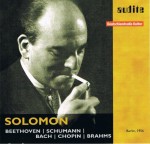 Just when we thought that there were no unreleased Solomon recordings, AUDITE has licensed 2CDs worth of recordings made in Berlin by the RIAS on February 23 and 24, 1956 (Audite 23.422). Solomon, for those who are unfamiliar with the name or his superlative musicianship, was a child prodigy (so who wasn’t, I hear you say) who continued to grow to become a supreme interpreter of Beethoven, Brahms, Schumann, and Chopin. He toured North America in 1955 with recitals of works by Beethoven, Bach, Mozart, Chopin, and Schumann. In this recording we hear two Beethoven sonatas, no.3 and The Moonlight, Schumann’s Carnaval, Bach’s Italian Concerto, Chopin’s Fantasie op.49, Nocturne op.9 no.1, and the Scherzo no.2 op.31. Three pieces by Brahms conclude this two hour recital, two Intermezzos and the Rhapsody in B minor, op.79 no.1. Exactly two hours of insightful interpretations played with ardour, elegance and panache (in the nicest sense) re-affirms Solomon’s place high on the honour role. After suffering a stroke during recording sessions in October 1956, he left the stage and lived until 1988 cared for by his wife. The liner notes have a mini bio and an appreciation of the pianist who, quite literally, became a legend in his own lifetime. Considering the artist and the repertoire, this is set to treasure.
Just when we thought that there were no unreleased Solomon recordings, AUDITE has licensed 2CDs worth of recordings made in Berlin by the RIAS on February 23 and 24, 1956 (Audite 23.422). Solomon, for those who are unfamiliar with the name or his superlative musicianship, was a child prodigy (so who wasn’t, I hear you say) who continued to grow to become a supreme interpreter of Beethoven, Brahms, Schumann, and Chopin. He toured North America in 1955 with recitals of works by Beethoven, Bach, Mozart, Chopin, and Schumann. In this recording we hear two Beethoven sonatas, no.3 and The Moonlight, Schumann’s Carnaval, Bach’s Italian Concerto, Chopin’s Fantasie op.49, Nocturne op.9 no.1, and the Scherzo no.2 op.31. Three pieces by Brahms conclude this two hour recital, two Intermezzos and the Rhapsody in B minor, op.79 no.1. Exactly two hours of insightful interpretations played with ardour, elegance and panache (in the nicest sense) re-affirms Solomon’s place high on the honour role. After suffering a stroke during recording sessions in October 1956, he left the stage and lived until 1988 cared for by his wife. The liner notes have a mini bio and an appreciation of the pianist who, quite literally, became a legend in his own lifetime. Considering the artist and the repertoire, this is set to treasure.
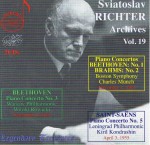 The year was 1960. The long awaited arrival of Sviatoslav Richter on the North American concert scene was greeted with excitement and enthusiasm. He was already an iconic figure and remains the most idolized cult figure of classical piano to this day. A new release from DOREMI (DHR-7972/3, 2 CDs) brings us for the first time his historic debut with the Boston Symphony Orchestra playing the First Beethoven Concerto and the mighty Brahms Second. This extraordinary concert was broadcast across the continent and can now be heard on CD for the first time in lucent, dynamic sound. It is thrilling to hear the resplendent Boston Symphony, “The Aristocrat of Orchestras,” in its heyday under the energetic Charles Munch accompanying Richter who was in top shape, technically and artistically. Also included is the Saint-Saëns fifth piano concerto with the legendary Leningrad Philharmonic Orchestra under Kiril Kondrashin from 1955 in a performance second to none in my memory. From the year before the Beethoven Piano Concerto No.3 with Witold Rowicki and the Warsaw Philharmonic Orchestra is a classic, stylistically pure performance.
The year was 1960. The long awaited arrival of Sviatoslav Richter on the North American concert scene was greeted with excitement and enthusiasm. He was already an iconic figure and remains the most idolized cult figure of classical piano to this day. A new release from DOREMI (DHR-7972/3, 2 CDs) brings us for the first time his historic debut with the Boston Symphony Orchestra playing the First Beethoven Concerto and the mighty Brahms Second. This extraordinary concert was broadcast across the continent and can now be heard on CD for the first time in lucent, dynamic sound. It is thrilling to hear the resplendent Boston Symphony, “The Aristocrat of Orchestras,” in its heyday under the energetic Charles Munch accompanying Richter who was in top shape, technically and artistically. Also included is the Saint-Saëns fifth piano concerto with the legendary Leningrad Philharmonic Orchestra under Kiril Kondrashin from 1955 in a performance second to none in my memory. From the year before the Beethoven Piano Concerto No.3 with Witold Rowicki and the Warsaw Philharmonic Orchestra is a classic, stylistically pure performance.
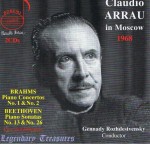 Claudio Arrau established himself as one of the very top classical pianists of all time. Almost 20 after his death he remains on the short list of critically acclaimed, elite pianists of the 20th century. His repertoire highlights were from the late classical and romantic eras, notably Brahms and Beethoven. Arrau probably led the field in live performances of the two Brahms Concertos, of which he made many esteemed recordings. Into the 1960s Arrau was still a titan of the keyboard and at the full technical and interpretative powers. He played both concertos in a memorable concert on May 31, 1968 in Moscow accompanied by Gennady Rozhdestvensky and the USSR TV and Radio Large Symphony Orchestra. Melodiya engineers were on hand to document this special event, subsequently issuing a limited edition of two stereo LPs. DOREMI has resurrected and restored these obscure recordings on a two CD set (DHR-7890/1). These are towering performances distilling the late pianist’s lifetime of devotion to this repertoire and his total understanding, absorption an insights supported by an empathetic conductor and his orchestra. They are heard in splendid stereo sound thanks to Melodiya’s engineering and DOREMI’s transfers. Two Beethoven sonatas, nos.13 and 26, from the same Moscow visit fill out these two discs.
Claudio Arrau established himself as one of the very top classical pianists of all time. Almost 20 after his death he remains on the short list of critically acclaimed, elite pianists of the 20th century. His repertoire highlights were from the late classical and romantic eras, notably Brahms and Beethoven. Arrau probably led the field in live performances of the two Brahms Concertos, of which he made many esteemed recordings. Into the 1960s Arrau was still a titan of the keyboard and at the full technical and interpretative powers. He played both concertos in a memorable concert on May 31, 1968 in Moscow accompanied by Gennady Rozhdestvensky and the USSR TV and Radio Large Symphony Orchestra. Melodiya engineers were on hand to document this special event, subsequently issuing a limited edition of two stereo LPs. DOREMI has resurrected and restored these obscure recordings on a two CD set (DHR-7890/1). These are towering performances distilling the late pianist’s lifetime of devotion to this repertoire and his total understanding, absorption an insights supported by an empathetic conductor and his orchestra. They are heard in splendid stereo sound thanks to Melodiya’s engineering and DOREMI’s transfers. Two Beethoven sonatas, nos.13 and 26, from the same Moscow visit fill out these two discs.
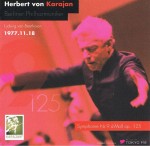 In November 1977, Herbert von Karajan and the Berlin Philharmonic Orchestra toured Japan. They opened with the Brahms Symphonies in Osaka from, including the Violin Concerto, the Double Concerto and the Second Piano Concerto. Their last concert there ended with a Karajan speciality, Ein Heldenleben. In the Fumonkan in Tokyo they performed the nine Beethoven Symphonies and two concertos with Alexis Weissenberg on six consecutive evenings. Tokyo FM has issued the nine symphonies on five CDs derived from their masters recorded in concert. The soloists in the Ninth Symphony (TFMC 0029) are soprano Barbara Hendricks, alto Heljä Angervo, tenor Herman Winkler, and bass Hans Sotin. The chorus is from The Tokyo University of the Arts. The sound in all nine is exemplary, quite perfect with enormous dynamic range and clarity, easily capturing the identity of every instrument. In the Ninth the tiers of sound of orchestra and choir alike are inspiring. These performances, all nine without exception, are a triumph for Beethoven. They do not represent a looking back at Beethoven but the promethean Beethoven’s declaration of independence without any pussy-footing at all from conductor or orchestra. In the Ninth, the soloists are really into it, while the choir is plainly elated and elating. To my mind, in every respect, this set is in a class by itself, eclipsing the other Karajan cycles and also those I have heard from other conductors. I bought my set from HMV Japan www.hmv.co.jp. Check Classical and then Karajan.
In November 1977, Herbert von Karajan and the Berlin Philharmonic Orchestra toured Japan. They opened with the Brahms Symphonies in Osaka from, including the Violin Concerto, the Double Concerto and the Second Piano Concerto. Their last concert there ended with a Karajan speciality, Ein Heldenleben. In the Fumonkan in Tokyo they performed the nine Beethoven Symphonies and two concertos with Alexis Weissenberg on six consecutive evenings. Tokyo FM has issued the nine symphonies on five CDs derived from their masters recorded in concert. The soloists in the Ninth Symphony (TFMC 0029) are soprano Barbara Hendricks, alto Heljä Angervo, tenor Herman Winkler, and bass Hans Sotin. The chorus is from The Tokyo University of the Arts. The sound in all nine is exemplary, quite perfect with enormous dynamic range and clarity, easily capturing the identity of every instrument. In the Ninth the tiers of sound of orchestra and choir alike are inspiring. These performances, all nine without exception, are a triumph for Beethoven. They do not represent a looking back at Beethoven but the promethean Beethoven’s declaration of independence without any pussy-footing at all from conductor or orchestra. In the Ninth, the soloists are really into it, while the choir is plainly elated and elating. To my mind, in every respect, this set is in a class by itself, eclipsing the other Karajan cycles and also those I have heard from other conductors. I bought my set from HMV Japan www.hmv.co.jp. Check Classical and then Karajan.


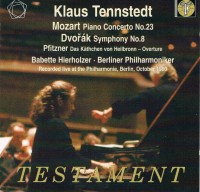
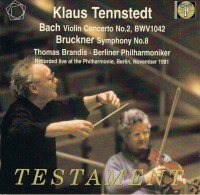
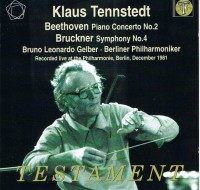
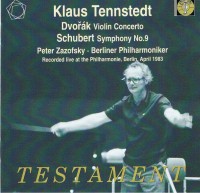
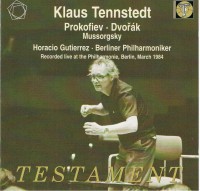
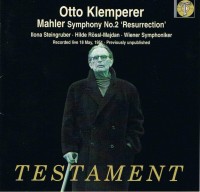
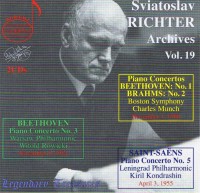
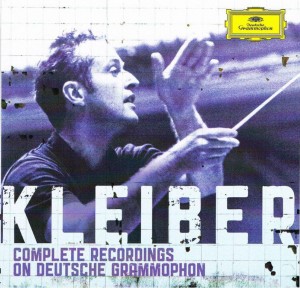
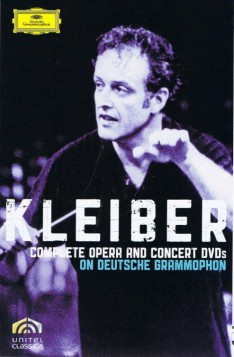
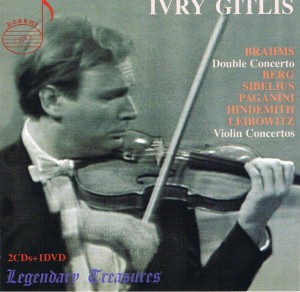
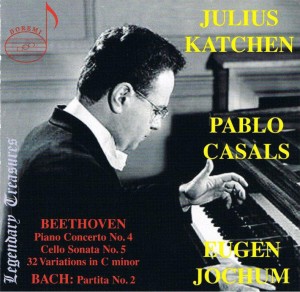
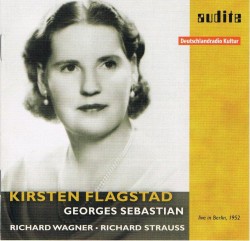
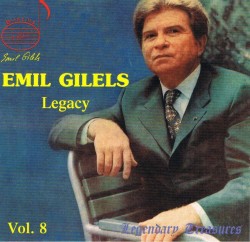
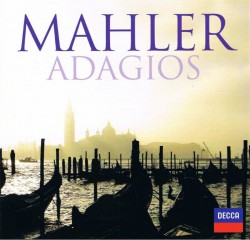
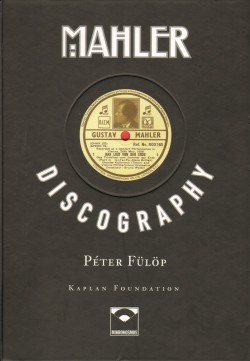
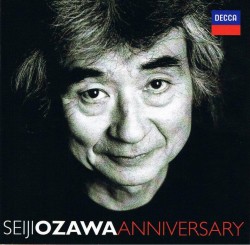
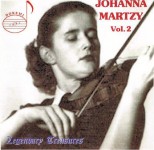
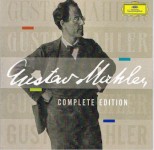
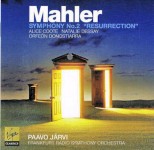
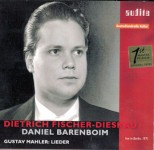
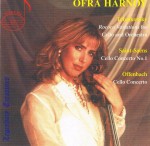
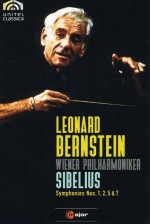
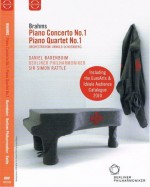
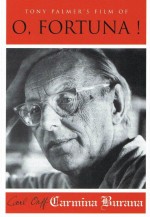
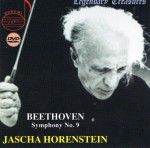
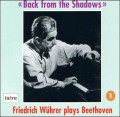
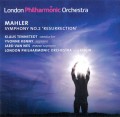
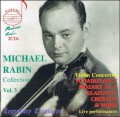
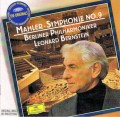
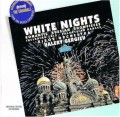
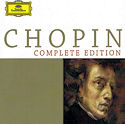 First up is Chopin (March 1) whose entire published works fit nicely on 16 or 17 CDs. The absolute pick of the packages comes from Deutsche Grammophon (4778445, 17 CDs) which also happens to be at an attractive price, particularly for German pressings. Every opus number is represented here in excellent to superlative performances. One could not hope for a better group of artists, mainly pianists, of course, than DG has assembled from their own catalogue plus Decca and Philips. Krystian Zimerman’s acclaimed 1999 performances of the two piano concertos with the Polish Festival Orchestra are on the first disc. Zimerman is heard again in the Ballades. Claudio Arrau is the soloist in the other concerted works. Maurizio Pollini plays the Etudes, the Polonaises, the Scherzos and the 2nd and 3rd Sonatas. Maria João Pires plays all the Nocturnes and Vladimir Ashkenazy plays the complete Mazurkas, the Waltzes, and a host of miscellaneous pieces. The Beaux Arts Trio plays (you’ve guessed it) the Trio in G minor. Also heard from are Anatol Ugorski, Martha Argerich, Lilya Zilberstein, Yundi Li, Mstislav Rostropovich, Anner Bylsma, and others including Polish soprano Elzbieta Szmytka in the songs. The reasonably informative booklet includes a brief chronological table of Chopin’s life, plus recording data. All in all, this is a most pleasing and very recommendable collection.
First up is Chopin (March 1) whose entire published works fit nicely on 16 or 17 CDs. The absolute pick of the packages comes from Deutsche Grammophon (4778445, 17 CDs) which also happens to be at an attractive price, particularly for German pressings. Every opus number is represented here in excellent to superlative performances. One could not hope for a better group of artists, mainly pianists, of course, than DG has assembled from their own catalogue plus Decca and Philips. Krystian Zimerman’s acclaimed 1999 performances of the two piano concertos with the Polish Festival Orchestra are on the first disc. Zimerman is heard again in the Ballades. Claudio Arrau is the soloist in the other concerted works. Maurizio Pollini plays the Etudes, the Polonaises, the Scherzos and the 2nd and 3rd Sonatas. Maria João Pires plays all the Nocturnes and Vladimir Ashkenazy plays the complete Mazurkas, the Waltzes, and a host of miscellaneous pieces. The Beaux Arts Trio plays (you’ve guessed it) the Trio in G minor. Also heard from are Anatol Ugorski, Martha Argerich, Lilya Zilberstein, Yundi Li, Mstislav Rostropovich, Anner Bylsma, and others including Polish soprano Elzbieta Szmytka in the songs. The reasonably informative booklet includes a brief chronological table of Chopin’s life, plus recording data. All in all, this is a most pleasing and very recommendable collection.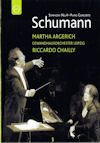 Robert Schumann was born in Saxony on June 8, 1810 and his output was many times that of his Polish contemporary including compositions in every form. Don’t expect to see a “complete” edition from any of the majors but new compilations have appeared this year from DG and Sony, neither of which I have seen or heard. EuroArts has issued a Blu-ray disc of on earlier DVD featuring Martha Argerich playing the Schumann Piano Concerto with Riccardo Chailly and the Leipzig Gewandhausorchester (EA2055494). Recorded “live” in June 2006 the Blu-ray disc presents the entire concert, adding the opening work, the Adagio and Allegro brillante from Etudes Symphoniques op.13, orchestrated by Tchaikovsky. The concerto emerges as an inspired collaboration between soloist and orchestra, without peer in this medium for sensitivity and intelligence. For an encore Argerich plays Of Foreign Lands and People from Kinderszenen, op.15. Following the intermission, the orchestra plays Ravel’s orchestration for Nijinsky of four pieces from Carnaval, op.9 followed by an enthusiastic and vital performance of the Fourth Symphony. The dynamics throughout are effortlessly true-to-life, making this a you-are-there experience.
Robert Schumann was born in Saxony on June 8, 1810 and his output was many times that of his Polish contemporary including compositions in every form. Don’t expect to see a “complete” edition from any of the majors but new compilations have appeared this year from DG and Sony, neither of which I have seen or heard. EuroArts has issued a Blu-ray disc of on earlier DVD featuring Martha Argerich playing the Schumann Piano Concerto with Riccardo Chailly and the Leipzig Gewandhausorchester (EA2055494). Recorded “live” in June 2006 the Blu-ray disc presents the entire concert, adding the opening work, the Adagio and Allegro brillante from Etudes Symphoniques op.13, orchestrated by Tchaikovsky. The concerto emerges as an inspired collaboration between soloist and orchestra, without peer in this medium for sensitivity and intelligence. For an encore Argerich plays Of Foreign Lands and People from Kinderszenen, op.15. Following the intermission, the orchestra plays Ravel’s orchestration for Nijinsky of four pieces from Carnaval, op.9 followed by an enthusiastic and vital performance of the Fourth Symphony. The dynamics throughout are effortlessly true-to-life, making this a you-are-there experience.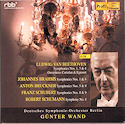 There is also a Schumann Fourth in a new boxed set from Profil featuring the late Günter Wand conducting the Deutsches Symphonie-Orchester Berlin in performances between April 1993 and April 1996 (PH09068, 8 CDs). One of the succession of famous conductors and music directors that has endowed this world-class orchestra - founded in 1946 by the American Forces in Berlin as the RIAS Symphony Orchestra - with a proud heritage, Wand looked beyond the printed score. His performances reflect the deepest commitment and focus so that it appears, at least to this listener, that in performance nothing exists but the composer’s creation. His Schumann unfolds organically with steady tempos and a true pulse. Amply dynamic, it is elegantly detailed and unusually compelling. So are three Beethoven Symphonies, one, three and four; Brahms First and Fourth; Bruckner’s Fifth and Ninth; and Schubert’s Eighth and Ninth. Brilliantly recorded, these are all from Wand’s favoured composers and his signature is on each one.
There is also a Schumann Fourth in a new boxed set from Profil featuring the late Günter Wand conducting the Deutsches Symphonie-Orchester Berlin in performances between April 1993 and April 1996 (PH09068, 8 CDs). One of the succession of famous conductors and music directors that has endowed this world-class orchestra - founded in 1946 by the American Forces in Berlin as the RIAS Symphony Orchestra - with a proud heritage, Wand looked beyond the printed score. His performances reflect the deepest commitment and focus so that it appears, at least to this listener, that in performance nothing exists but the composer’s creation. His Schumann unfolds organically with steady tempos and a true pulse. Amply dynamic, it is elegantly detailed and unusually compelling. So are three Beethoven Symphonies, one, three and four; Brahms First and Fourth; Bruckner’s Fifth and Ninth; and Schubert’s Eighth and Ninth. Brilliantly recorded, these are all from Wand’s favoured composers and his signature is on each one.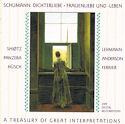 But back to Schumann... Music and Arts has issued an inspired two CD set containing historic recordings with three performances each of two song cycles from 1840, Dichterliebe and Frauenliebe und -leben (CD-1235). Dichterliebe is heard firstly by Aksel Schiøtz, the Danish tenor who recorded this cycle with Gerald Moore in 1946 just months before a necessary surgery left his face partially paralysed. Swiss baritone Charles Panzera is accompanied by Alfred Cortot in a 1935 recording that was, for many collectors, the criterion... yet Gerhard Hüsch, the German baritone, accompanied by Hanns Udo Müller, having the advantage of singing in his native tongue, sounds the most comfortable and expressive with Heine’s texts. Frauenliebe und –leben with texts by Adalbert von Chamisso is for female voice. Three singers, each indisputably legendary in the very best sense of the word, are each so individual in style that comparisons would indeed be odious. Here is Lotte Lehmann live in recital with Paul Ulanowsky in New York in 1946 and contralto Marian Anderson with Franz Rupp in 1950. Finally, Kathleen Ferrier is heard live at the Edinburgh Festival in 1949 accompanied by... no in collaboration with... her mentor, Bruno Walter. Excellent transfers make listening a pleasure. Comprehensive liner notes are included.
But back to Schumann... Music and Arts has issued an inspired two CD set containing historic recordings with three performances each of two song cycles from 1840, Dichterliebe and Frauenliebe und -leben (CD-1235). Dichterliebe is heard firstly by Aksel Schiøtz, the Danish tenor who recorded this cycle with Gerald Moore in 1946 just months before a necessary surgery left his face partially paralysed. Swiss baritone Charles Panzera is accompanied by Alfred Cortot in a 1935 recording that was, for many collectors, the criterion... yet Gerhard Hüsch, the German baritone, accompanied by Hanns Udo Müller, having the advantage of singing in his native tongue, sounds the most comfortable and expressive with Heine’s texts. Frauenliebe und –leben with texts by Adalbert von Chamisso is for female voice. Three singers, each indisputably legendary in the very best sense of the word, are each so individual in style that comparisons would indeed be odious. Here is Lotte Lehmann live in recital with Paul Ulanowsky in New York in 1946 and contralto Marian Anderson with Franz Rupp in 1950. Finally, Kathleen Ferrier is heard live at the Edinburgh Festival in 1949 accompanied by... no in collaboration with... her mentor, Bruno Walter. Excellent transfers make listening a pleasure. Comprehensive liner notes are included.